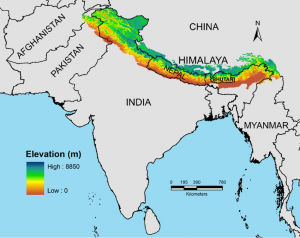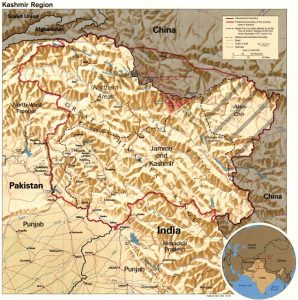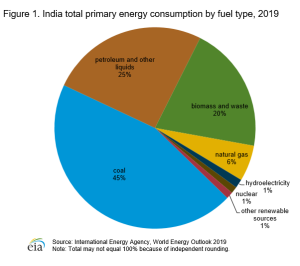11
By Isabella Clowes, Nora Smith, and Alexander Wadsworth
The Himalayas
While many parts of Asia hold global significance, the Himalayas are a more localized region with great importance. They span roughly 1,500 miles, passing through 6 countries including Pakistan, China, and India (Figure 1). The area focused on in this paper is the Jammu and Kashmir region of India, which is located in the north of the country of India.

Since the range passes through multiple countries, the cultures there are largely isolated. People have lived there since ancient times, and the indigenous population generally falls into one of three groups: Hindu, Buddhist, and Islamic. Because of the isolation that living in the Himalayas brings, the population demographics are very different from Jammu and Kashmir – the Indian region where the Himalayas are located – as a whole. While the region is about two-thirds Islamic (Kirk & Akhtar, 2019), the mountains themselves are nearly equal parts Islamic and Buddhist, with a minority Hindu population (Bishop & Chatterjee, 2020). The population density in the Himalayas is also much smaller than the majority of the country (CIA World Factbook). Culturally, the Himalayas are the home of sacred places for multiple religions. Many Buddhist monasteries can be found in the region, and a monastery located in Bhutan has been thought to be the local birthplace of Buddhism (Cantor, 2017). Additionally, Hinduism has long personified the mountains as “Giriraj Himavat,” the king of all mountains (Dallapiccola, 2002).
The Jammu and Kashmir region is an underdeveloped Union Territory along the Himalayas. Much of the region’s economy is dependent on a diverse range of agriculture due to the distinct types of landscapes present. They grow mostly summer crops, including rice, corn, millet, pulses, cotton, and tobacco along with a wheat and barley as spring crops (Bishop & Chatterjee, 2020). The region is also rich with silk and fruit cultivation, most from the breeding of the Kashmir goat and farming from orchards within the Vale of Kashmir (Bishop & Chatterjee, 2020). These crops and textiles make up most of the state’s $1.56 trillion GDP, as well as being supply goods for cities within the region itself (India Brand Equity Foundation, 2020).

This agricultural industry is the most susceptible to climate change within the region. Meteorological data from the region shows an annual decrease in summertime precipitation of about 20mm as well as an increase mean temperature of around 0.75 degrees Celsius (Rasool et al., 2018). This change in rainfall and temperature changes the agricultural properties of the some of the regions inside of Jammu and Kashmir, leading to lower crop yields (Rasool et al., 2018). As a result, many farming regions within the state are changing from agriculture to horticulture, where a larger variety of crops are grown with a reduced yield.
The state of Jammu and Kashmir is considered a low-income country because of its lack of major industry and its population’s quality of life. The only major industry within the region, besides agriculture, is their traditional handicraft industry, which is encompassed by the skills of weaving, pottery, and basketry (India Brand Equity Foundation, 2020). While this production of goods does employ 340,000 people from the Jammu and Kashmir region, it does not provide a large income, with 67.4% of households reporting that their highest paid member makes less than 5000 rupees, or $67.59 (Government of Jammu and Kashmir, 2017).
Jammu and Kashmir’s proximity to the Himalayas gives the region a large and reliable source of water. Most of the water for the region comes from rivers, such as the Jhelum, Indus, Chenab, and Tawi river, which originate from glaciers and lakes within the mountain range (Ministry of Environment and Forests Government of India, 2016). All these water resources lie within the Jammu and Kashmir region and do not have to be imported. The previously mentioned rivers also have the ability provide a large and renewable energy output that could supply the energy for the region and India as a whole. India is mostly powered by fossil fuels, more specifically, coal, petroleum, and biomass, which account for 91% of all energy production, which can be seen in Figure 3 (U.S. Energy Information Administration, 2020). However, using hydroelectric power, the Tawi River alone could generate 23 MW of power, helping to lessen the severe effects of climate change created by the energy habits of the rest of the country (Ministry of Environment and Forests Government of India, 2016).

The general climate of the Himalayas matters to more than just the mountains themselves. Seasons in this region are different from those experienced in most of the world. Instead of winter, spring, fall, and summer, they have a wet and a dry season that switch when the monsoon wind changes directions. During colder months, the wind blows down from the northeast bringing dry air but then during the warmer months it blows up from the southwest bringing rain (Shanmugasundaram et al., 2018). Different parts of the Himalayas experience the wet season at separate times of the year. The height of the mountain range takes much of the moisture out of monsoons moving north, leading to wet conditions in India but drier, arid conditions in the country of Tibet (Bishop & Chatterjee, 2020). Four types of ecosystems are present on the mountain. The base of the Himalayas is made up of tropical rainforests, followed by more typical seasonal forests. Higher up are coniferous forests, composed of pine and yew, and finally at the highest elevations are grasslands and shrublands (PBS, 2020). Each zone is determined by elevation, as elevation determines not only general temperature, but also type and amount of precipitation. As a result of these different zones being relatively close, the Himalayas hold great biodiversity. Nepal, a country nearly entirely covered by the Himalayas, highlights this; despite the country making up 0.1% of the global land mass, the region holds 2% of the world’s flowering plants and 8.9% of the world’s birds, as well as nearly 4% of the world’s mammals (Paudel & Bhattarai, 2011). Therefore, any change in climate would not only devastate human populations in India, but also affect massive amounts of plant and animal life. Their central location, multiple large river basins, and thousands of glaciers make the Himalayas a crucial part of all of Asia’s life.
Jammu and Kashmir are in danger of losing critical resources and suffering drastic changes to the current climate that they rely on. An increase of one or two degrees Celsius by 2050 in this region is likely, which would lead to more inconsistencies in the monsoon, with an overall decrease in yearly precipitation (Sachidananda, et al., 2018). Agriculture yields are expected to decrease due to droughts, leading to more food insecurity and malnutrition. With less water, hydropower plants will be less effective, decreasing energy production. Drier conditions will allow more forest fires to rip through the trees, not only destroying resources for humans but also harming the unique biodiversity of the Himalayas. More climate related deaths will occur each year due to intense weather events, malnutrition, or lack of water (Sachidananda, et al., 2018).
So, what can be done to protect the state of Jammu and Kashmir from these horrible effects? To start, innovative technologies would have to be implemented to better the storage, distribution, and use of water. More effective irrigation methods that conserve water could be used to reduce the strain that agriculture puts on freshwater resources. This could include drip irrigation which slowly drips water onto crops to ensure every drop gets soaked up by the plant (Shock, 2014). Diversifying the types of crops grown would provide a reliable yield each year even if diseases, droughts, or pests, wipe out some of the susceptible plant species. New committees or programs would have to be created to manage forests, wildlife, and watersheds as well as protect the diverse ecosystems (Shanmugasundaram et al., 2018). One such program that proactively supports the protection of Himalayan ecosystems is the Indian Himalayas Climate Adaptation Programme. A method this group uses to help protect the Himalayas is teaching courses such as glaciology and other related topics to young researchers and scientists, encouraging them to pursue research into Himalayan climate change (IHCAP, 2018). Since the region is very underdeveloped and lower income compared to the rest of India, a lot of government funding and knowledge is required to implement these plans. Luckily, India has been preparing for this and, under the National Adaptation Fund for Climate Change, has given grants to Jammu and Kashmir to fund agricultural adaptations (Sachidananda, et al., 2018). To truly save this region and its diverse wildlife, the rest of India and the world would have to adopt more sustainable lifestyles and focus all its efforts on fighting against climate change.
References
Ali, A., Rahut, D. B., Mottaleb, K. A., & Erenstein, O. (2017). Impacts of changing weather patterns on smallholder well-being: Evidence from the Himalayan region of northern Pakistan. International Journal of Climate Change Strategies and Management, 9(2), 225-240. https://doi.org/10.1108/IJCCSM-05-2016-0057
Bishop, B. C., & Chatterjee, S. P. (2020, October 30). Himalayas, Britannica. Retrieved November 28, 2020, from https://www.britannica.com/place/Himalayas
Cantor, K. (2017, December 6). Paro, Bhutan: The Tiger’s Nest, Huffpost. Retrieved November 29, 2020, from https://www.huffpost.com/entry/paro-bhutan-the-tigers-ne_b_10982104
Central Intelligence Agency. (2018, February 01). India. The World Factbook. Retrieved November 28, 2020, from https://www.cia.gov/library/publications/resources/the-world-factbook/index.html
Central Intelligence Agency. (1990) Kashmir Region. [Washington: Central Intelligence Agency] [Map] Retrieved from the Library of Congress, https://www.loc.gov/item/91682088/ .
Dallapicolla, A. L. (2002). Dictionary of Hindu lore and legend. New York, NY: Thames & Hudson. Retrieved November 28, 2020, from https://archive.org/details/dictionaryofhind0000dall.
Government of Jammu and Kashmir. (2017). Economic Survey 2017. Directorate of Economics and Statistics J&K. http://ecostatjk.nic.in/Economic%20Survey%202017.pdf
The Himalayas. (2020, April 10). Nature. Retrieved November 30, 2020, from https://www.pbs.org/wnet/nature/the-himalayas-himalayas-facts/6341/
IHCAP (Indian Himalayan Climate Adaptation Programme). (2018). About IHCAP. Retrieved December 03, 2020, from http://ihcap.in/about-ihcap
India Brand Equity Foundation. (2020, November 17). Jammu and Kashmir Presentation and Economic Growth Report. IBEF. https://www.ibef.org/states/jammu-and-kashmir-presentation
Kirk, W., & Akhtar, R. (2019, October 31). Jammu and Kashmir, Britannica. Retrieved November 28, 2020, from https://www.britannica.com/place/Jammu-and-Kashmir
2018. Geophysical upheavals and evolutionary diversification of plant species in the Himalaya. PeerJ 6:e5919. https://doi.org/10.7717/peerj.5919
Ministry of Environment and Forests Government of India. (2016). Water Resources. J&K ENVIS Centre. http://jkenvis.org/water_resources_introduction.html
Nishikant G., Mishra, A., Agrawal, N. K., Satapathy, S. (2018). Interstate Cooperation for Climate Change Adaptation in Indian Himalayan Region. Economic & Political Weekly, 53(12). https://www.epw.in/journal/2018/12/perspectives/interstate-cooperation-climate-change-adaptation-indian-himalayan
Paudel, P. K., & Bhattarai, B. P. (2011). An Overview of the Biodiversity in Nepal. In P. Kindlmann (Ed.), Himalayan biodiversity in the changing world (pp. 1-40). Berlin, Germany: Springer Science & Business Media.
Rasool, R., ul Shafiq, M., Ahmed, P., & Ahmad, P. (2018). An analysis of climatic and human induced determinants of agriculture land use changes in Shupiyan area of Jammu and Kashmir state, India. GeoJournal, 83, 49-60. https://doi.org/10.1007/s10708-016-9755-6
Shanmugasundaram, J., Lee, E., & Srinivasan, G. (2018). Characterizing pentad rainfall variations during the North-East Indian monsoon season over the southeastern peninsular India. International Journal of Climatology, 38(S1), e1044-e1060. https://doi.org/10.1002/joc.5432
Sharma, E., Molden, D., Rahman, A., Khatiwada, Y., Zhang, L., Singh, S., Yao, T., & Wester, P. (2019). The Hindu Kush Himalaya Assessment. Springer. https://doi.org/10.1007/978-3-319-92288-1
Shock, C. (2014, August). An Introduction to Drip Irrigation. College of Agricultural Sciences, Oregon State University. https://agsci.oregonstate.edu/mes/irrigation/introduction-drip-irrigation.
Singh, S., Kumar, R., Bhardwaj, A., Sam, L., Shekhar, M., Singh, A., Kumar, R, & Gupta, A. (2016). Changing climate and glacio-hydrology in Indian Himalayan Region: A review. Wiley Interdisciplinary Reviews: Climate Change, 7(3), 393-410. https://doi.org/10.1002/wcc.393
U.S. Energy Information Administration. (2020, September 30). India. Independent Statistics
and Analysis. https://www.eia.gov/international/analysis/country/IND
Zurick, D., Pacheco, J., Shrestha, B. R., & Bajracharya, B. (2006). Illustrated atlas of the Himalaya. Lexington, KY: University Press of Kentucky.
